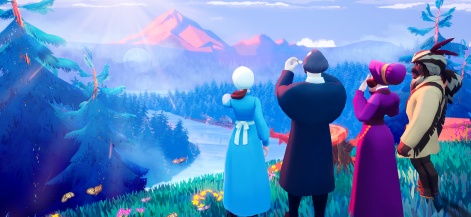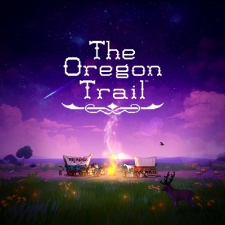The process of creating a game is difficult, long, and often stressful.
No matter the size of the game or how long it ultimately takes to make, each new title involves a lot of hard work, tough decisions, and a little bit of luck before it even gets out the door and onto devices.
And in the current market, that's only the first step to making the title succeed.
To highlight the extensive work that goes unseen in the background, PocketGamer.biz is reaching out to developers to learn more about the process of releasing a video game, with our 'Making Of' series.
This week, we spoke with Gameloft Brisbane creative director Jarrad Trudgen and art director Liz Ballantyne on Apple Arcade title The Oregon Trail.
PocketGamer.biz: Can you start off by telling us about The Oregon Trail?
Jarrad Trudgen: The Oregon Trail is a game franchise that started in the 1970s as an educational game about westward expansion in the US in the 1800s, with the classic version in 1985 on the Apple II being the most memorable to people.
Historically, The Oregon Trail is the collective story of the thousands of emigrants who bundled their belongings into wagons and attempted a perilous journey with their families across over 2,000 miles of rugged terrain from Independence to Oregon – many of whom did not survive but over time the titular "Oregon Trail" was established.
Where did the initial idea for the game come from?
Jarrad Trudgen: Although this is the Brisbane studio’s first Oregon Trail game, Gameloft actually has a fairly long history with the franchise, developing a few different entries since 2009.
We set out to recreate the classic, but with a beautiful blend of charming pixel art, 3D environments and cutting-edge lighting and visual effects.Liz Ballantyne
Brisbane’s previous game, Ballistic Baseball, was designed for Apple Arcade and we really wanted to make another title for the service.
It’s the perfect platform for our vision of The Oregon Trail in 2021 – an authentic, highly replayable and nostalgic reimagining of the classic 1985 version with a striking art style and design that leans into and expands the roguelike elements of the original.
How long did development take, and how many people worked on the game?
Jarrad Trudgen: Development took approximately 15 months and 30 people in the Brisbane studio – though we have other teams that assisted like our audio team in Montreal and narrative team in New York.
What was the biggest challenge you had to overcome during development?
Jarrad Trudgen: The biggest challenge was determining how to honour the original game and remain true to its spirit while also updating the design with more contemporary elements for a modern audience.
To that end, we really kept practically all of the original games’ features and then expanded further on them.
Liz Ballantyne: Originally headquarters came to us with the idea to reimagine the Oregon Trail while upholding its pixel art style. Over the years we’d seen many versions of the nostalgic classic and we knew pixel art was the right approach to take.
Our art team, however, was a predominately 3D team and we needed to think carefully and quickly about how to best achieve this art style.

We looked for solutions and tried multiple techniques, before we settled on a custom pipeline - modelling and animating our characters in 3D, then rendering and refining each pixel by hand. Understanding the mountain we faced, we hired a talented Pixel Artist in the end too! It was a rollercoaster of ups and downs to establish our final look.
At what stage in development did you feel you had a game that you were happy with?
Jarrad Trudgen: This was one of those rare projects where we were fairly confident quite early on that we were onto something. It wasn’t actually until the last few weeks that everything really came together in terms of balancing.
Liz Ballantyne: I remember feeling super excited about one of our first prototypes. By the time the team had hit a vertical slice, we’d be able to polish a large chunk of the game! It’s rare for a game to come together so quickly and smoothly.
Talk to us about the art style choice?
Liz Ballantyne: We looked extensively at the original game, deconstructing it into its key defining areas – the limited colour palette, the composition of the iconic oxen and wagon, characters and environments.
We set out to recreate the classic, but with a beautiful blend of charming pixel art, 3D environments and cutting-edge lighting and visual effects.
We know how beloved this series is to these players so it has been very important to us that we capture the spirit of the original...Jarrad Trudgen
Early on we spent a lot of time recreating the prairies; we wanted to ensure it evoked the feeling of the nostalgic green trail. We researched different areas extensively, reading travellers journals from the era that described the landscape in a way more beautiful than we could ever imagine.
Some of the most beautiful environments are the deserts, rivers and snow-capped mountains, combined with modem lighting and effects added another layer of depth and life to the game.
Who composed the music and what feeling were you trying to evoke with the score?
Jarrad Trudgen: The music for the game is an original score composed and recorded by Nicolas Dube, a member of our super talented audio team in Montreal - Nicolas composed and played everything on the soundtrack!
Where the previous The Oregon Trail titles used a lighter, fun score aimed at a younger audience we wanted a more mature, moody, contemporary alt-country inspired score that evoked romance, melancholy, hope and adventure.
How did the partnership come about with Apple? Was the game always planned as an exclusive to the platform?
Jarrad Trudgen: We had such a good experience making our previous title, Ballistic Baseball, for Apple Arcade that we had let Apple know we would love our next project to be on the platform, too, and pitched the idea of The Oregon Trail reimagining.
So yes, we had always envisioned this as an Apple Arcade exclusive – the classic 1985 version we are referencing was on Apple II so it just made sense that our new take should be at home on Apple, too.
How long is the exclusivity window? Will it arrive on other platforms such as Android or Switch in future?
Jarrad Trudgen: There are currently no plans to release The Oregon Trail on other platforms - it’s an Apple Arcade exclusive. We’re proud to be a part of the platform and sitting alongside some of the amazing, high-quality games that have just launched in the most recent update.
Who do you find to be the game's main audience?
Jarrad Trudgen: Though still family-friendly, this new game is aimed squarely at The Oregon Trail generation; the kids who played this at school in the 80s and early 90s who are now adults, perhaps with kids of their own.
We know how beloved this series is to these players so it has been very important to us that we capture the spirit of the original – the difficulty, the randomness, the sudden misfortunes, naming characters and writing their gravestones – but also update it with beautiful visuals and some more design depth to bolster replayability even more.
What can you tell us about your plans in terms of updates?
Jarrad Trudgen: The team is actively working on updates for The Oregon Trail. We are keen to respond to all the great feedback and suggestions we are getting from the community and have a bunch of fresh content and exciting new features we want to add in the coming months.
What can you tell us about your future projects?
Jarrad Trudgen: We’re currently pitching some concepts for future projects, too, but I can’t say much more than that at the moment.






















